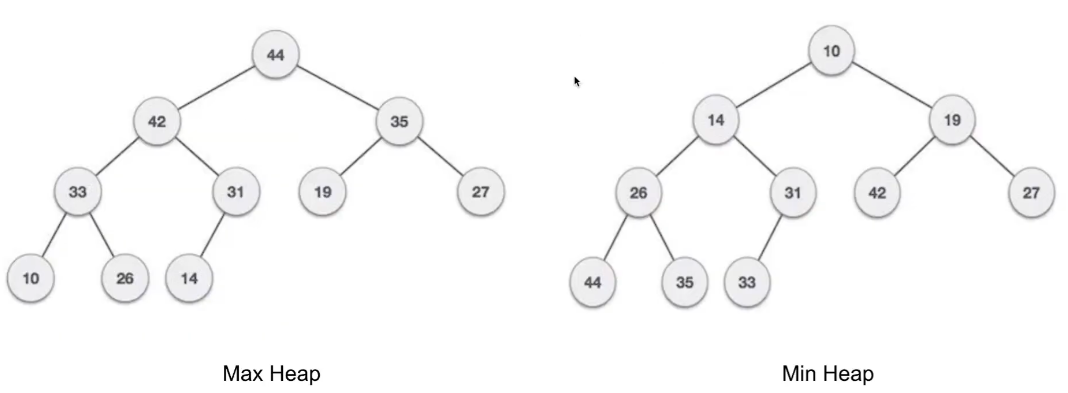优先队列 PriorityQueue, 堆 Heap
优先队列 PriorityQueue
类似链表,由多个节点组成。
- push: 插入一个新的元素
- pop: 将优先级最高的元素弹出 (删除)
- peek: 查看优先级最高的元素数值
- isEmpty

Java Implementation
public class PriorityQueue {
static class Node {
int value;
int priority;
Node next;
public Node (int value, int priority) {
this.value = value;
this.priority = priority;
}
}
Node head = null;
// push 方法的时间复杂度是 O(n), 仍可以进行优化
public void push (int value, int priority) {
if (head == null) {
head = new Node(value, priority);
return;
}
Node current = head;
Node newNode = new Node(value, priority);
if (head.priority < priority) {
newNode.next = head;
head = newNode;
} else {
while (current.next != null && current.next.priority > priority ) {
current = current.next;
}
newNode.next = current.next;
current.next = newNode;
}
}
public Node peek() {
return head;
}
public Node pop() {
if (head == null) {
return null;
}
Node temp = head;
head = head.next;
return temp
}
public booelan isEmpty() {
return head == null;
}
}
堆 Heap
Heap 属于完全二叉树 (Complete Binary Tree)。
- insert: 将新元素插入堆
- poll: 将根节点 (数值最大的元素) 删除
- peek: 获取根节点的数值

实现思路
插入 insert
- 在堆的最后新建一个节点。
- 将数值赋予新节点。
- 将新节点和父节点比较。
- 如果新节点的数值比父节点大,调换父子节点的位置。
- 重复步骤 3 和 4 指导最大堆的特性被满足
移除 poll
- 移除根节点
- 将最后的元素移到根节点处
- 将子节点和父节点比较。
- 如果父节点的数值与较大的子节点的数值对比,父节点比较小的话,调换父子节点的位置。
- 重复步骤 3 和 4 指导最大堆的特性被满足
Java Implementation
public class MaxHeap {
private int capacity;
private int size = 0;
private int[] array;
public MaxHeap(int capacity) {
this.capacity = capacity;
this.array = new int[capacity];
}
private int getLeftChildIndex(int parentIndex) {
return 2 * parentIndex + 1;
}
private int getRightChildIndex(int parentIndex) {
return 2 * parentIndex + 2;
}
private int getParentIndex(int childIndex) {
return (childIndex-1)/2;
}
private boolean hasLeftChild(int index) {
return getLeftChildIndex(index) < size;
}
private boolean hasRightChild(int index) {
return getRightChildIndex(index) < size;
}
private boolean hasParent(int index) {
return getParentIndex(index) < size;
}
private int leftChild(int parentIndex) {
return array[getLeftChildIndex(parentIndex)];
}
private int rightChild(int parentIndex) {
return array[getRightCHildIndex(parentIndex)];
}
private int parent(int childIndex) {
return array[getParentIndex(childIndex)];
}
public void insert(int item) { // Time Complexity: O(logN)
if (size == capacity) {
array = Array.copyOf(array, capacity * 2);
capacity = capacity * 2;
}
array[size] = item;
size++;
heapifyUp();
}
private void heapifyUp() {
int index = size - 1;
while(hasParent(index) && parent(index) < array[index]) {
swap(getParentIndex(index), index);
index = getParentIndex(index);
}
}
private void swap(index_1, index_2) {
int tmp = array[index_1];
array[index_1] = array[index_2];
array[index_2] = tmp;
}
public void poll() { // Time Complexity: O(logN)
if(size == 0) {
throw new NoSuchElementException();
}
int element = array[0];
array[0] = array[size-1];
size--;
heapifyDown();
}
private void heapifyDown() {
int index = 0;
while(hasLeftChild(index)) { // Because of the feature of Complete Binary Tree
int largerChildIndex = getLeftChildIndex(idnex);
if(hasRightChild(index) && rightChild(index) > leftChild(index)) {
largerChildIndex = getRightChildIndex(index);
}
if(array[index] < array[largerChildIndex]) {
swap(index, largerChildIndex);
} else {
break;
}
index = largerChildIndex;
}
}
private int peek() {
if (size == 0) {
throw new NoSuchElementException();
}
return array[0];
}
}
来源
- 优先队列 PriorityQueue, 堆 Heap【数据结构和算法入门 8】: https://www.youtube.com/watch?v=wTAoOhytiQs&list=PLV5qT67glKSGFkKRDyuMfwcL-hwXOc4q_&index=8